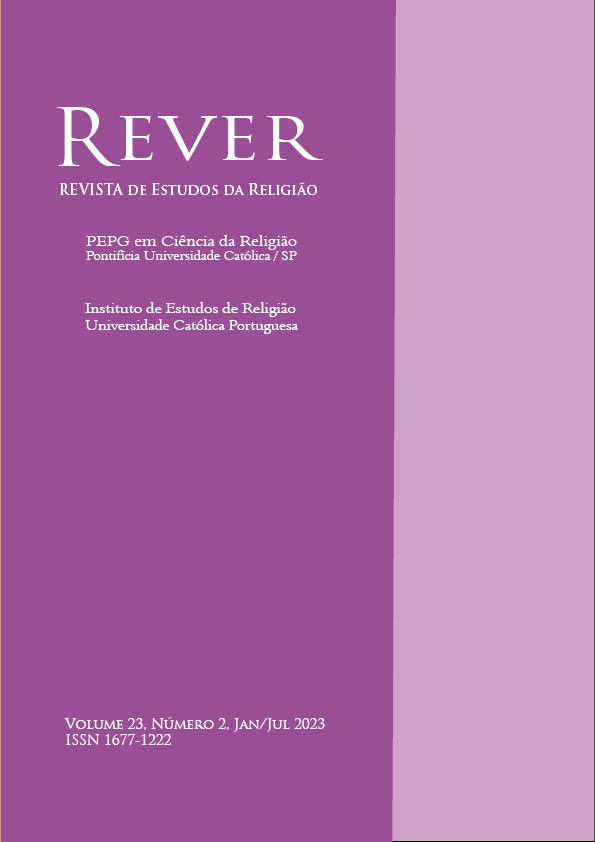A alegoria do diabo como crítica irônica ao capitalismo na obra de Machado de Assis
DOI:
https://doi.org/10.23925/1677-1222.2023vol23i1a6Palavras-chave:
Machado de Assis, A Igreja do Diabo, Sermão do Diabo, Capitalismo, IroniaResumo
Entre os diversos percursos analíticos relativos à obra de Machado de Assis, um dos que mais parece chamar a atenção é aquele que busca aproximações entre os discursos literário e religioso (Cantarela, 2015; Alves; Oliveira; Ivan, 2014; Maia, 2015; Silva, 2016; Proença, 2010; Nova, 1992; Schmidt; Silva, 1978; Brum, 2009). Nesse sentido, para Cantarela (2015), existiriam pelo menos três modelos de leitura do diálogo entre religião e literatura, quais sejam: (a) o modelo dialógico da literatura comparada (caracterizado pela busca de traços de intertextualidade entre a Bíblia e outras obras canonizadas pelas tradições religiosas com a literatura); (b) o modelo dialógico teorizado (caracterizado pela busca de justificativas teóricas para o diálogo entre religião e literatura); e, por fim, o (c) modelo dialógico temático (compreende que a interlocução entre o discurso teológico e o literário pode ser construído a partir de elementos do mundo vivido e com foco em variados temas). Para fins específicos deste artigo, optamos por um modelo analítico que compreenda tanto o dialógico de literatura comparada quanto o dialógico temático. Seguimos esse caminho, já que o nosso objetivo consiste, fundamentalmente, em analisar, nos contos machadianos A Igreja do Diabo e o Sermão do Diabo, a forma como o autor faz uma crítica social irônica ao capitalismo brasileiro de fins do século XIX e início do século XX. É importante destacar que, embora haja obras que tenham a temática da crítica social como um elemento central (Couto, 2016; Bosi, 2004), nenhuma delas parte da alegoria do Diabo.
Referências
ALVES, Naiara da Silva; OLIVEIRA, Rafaela Veríssimo Paim de; IVAN, Maria Eloísa de Souza. Entre o sagrado e o profano: uma leitura do conto “A igreja do diabo” de Machado de Assis. Revista Eletrônica de Letras, (on-line), v. 7, n. 7, edição 7, jan.-dez. 2014.
ASSIS, Machado de. A Igreja do Diabo. Rio de Janeiro: Garnier, 1884. (Volume de contos). Disponível em: <http://www.dominiopublico.gov.br/download/texto/bv000195.pdf>. Acesso em: 8 dez. 2022.
ASSIS, Machado de. O Sermão do Diabo. Rio de Janeiro: Garnier, 1884. (Volume de contos). Disponível em: <http://www.dominiopublico.gov.br/download/texto/bv000195.pdf>. Acesso em: 8 dez. 2022.
BAKTHIN, Mikhail. A cultura popular na Idade Média e no Renascimento: o contexto de François Rabelais. São Paulo: Hucitec, 2010.
BÍBLIA SAGRADA. Tradução dos originais grego, hebraico e aramaico mediante a versão dos Monges Beneditinos de Maredsous (Bélgica). São Paulo: Editora Ave-Maria, 2013.
BOSI, Alfredo. Raymundo Faoro leitor de Machado de Assis. Estudos Avançados, [s.l.], v. 18, n. 51, 2004.
BRUM, Fernando Machado. Literatura e religião: estudo das referências religiosas na obra de Machado de Assis. 2009, 181f. (Dissertação de Mestrado em Literatura Brasileira), Universidade Federal do Rio Grande do Sul, Campus de Porto Alegre, Porto Alegre, 2009.
CANDIDO, Antonio. Vários escritos. Rio de Janeiro: Ouro sobre Azul, 2011.
CANTARELA, Antonio Geraldo. Modelos de leitura do diálogo entre religião e literatura. In: CONGRESSO NPTECRE, v. 5, 2015. Anais […]. [S.l.], 2015.
CHARAUDEAU, Patrick. “Dize-me qual é teu corpus, eu te direi qual é a tua problemática”. Revista Diadorim (Revista de Estudos Linguísticos e Literários do Programa de Pós-Graduação em Letras Vernáculas da Universidade Federal do Rio de Janeiro), Rio de Janeiro, v. 10, 2011.
CHARAUDEAU, Patrick. Os estereótipos, muito bem. Os imaginários, ainda melhor. Entrepalavras, [s.l.], v. 7, 2017.
CHARAUDEAU, Patrick. Linguagem e discurso: modos de organização. São Paulo: Contexto, 2019.
COUTO, Elvis Paulo. Roberto Schwarz e a crítica social na literatura de Machado de Assis. Revista Florestan Fernandes, [s.l.], v. 3, n. 1, 2016.
DELUMEAU, Jean. História do medo no Ocidente. São Paulo: Companhia das Letras, 2009.
MAIA, Hélen Suzandrey Borges. A representação do diabo no conto machadiano “A Igreja do Diabo”: sua formação palimpsestica com o Livro de Jó e Fausto de Goethe. In: CONGRESSO ANPTECRE, v. 5, 2015. Anais […]. [S.l.], 2015.
MINOIS, Georges. História do riso e do escárnio. São Paulo: Editora Unesp, 2003.
NOVA, Vera Casa. Do sermão do Diabo: o avesso da narrativa. O Eixo e a Roda, [s.l.], v. 16, 1992.
PEREIRA, Kênia Maria de Almeida. A poética da resistência em Bento Teixeira e Antônio José da Silva, o Judeu. São Paulo: Annablume, 1998.
PROENÇA, Paulo Sérgio de. Intertextualidade bíblica e escravidão em Machado de Assis (duas crônicas de maio de 1888). Revista Estudos Semióticos, [s.l.], v. 6, n. 2, p. 77-85, novembro de 2010.
SCHMIDT, Zilia Mara Scarpari; SILVA, Edson Rosa da. A Igreja do Diabo e o discurso do carnaval. Curitiba: Revista de Letras, 1978.
SILVA, Tiago Ferreira da. A Bíblia às avessas: uma releitura irônica do Gênesis no conto ‘Na arca’, de Machado de Assis. Revista Exodus: Contos e Recontos, [s.l.], 2016.
SOARES, Angélica. Gêneros literários. São Paulo: Ática, 2004.
Downloads
Publicado
Como Citar
Edição
Seção
Licença

Este trabalho está licenciado sob uma licença Creative Commons Attribution-NonCommercial 4.0 International License.
Autores que publicam nesta revista concordam com os seguintes termos:
- Autores mantém os direitos autorais e concedem à revista o direito de primeira publicação, com o trabalho simultaneamente licenciado sob a Licença Attribution-NonCommercial 4.0 International, que permite o compartilhamento do trabalho com reconhecimento da autoria e publicação inicial nesta revista.
- Autores têm autorização para assumir contratos adicionais separadamente, para distribuição não exclusiva da versão do trabalho publicada nesta revista (ex.: publicar em repositório institucional ou como capítulo de livro), com reconhecimento de autoria e publicação inicial nesta revista.


